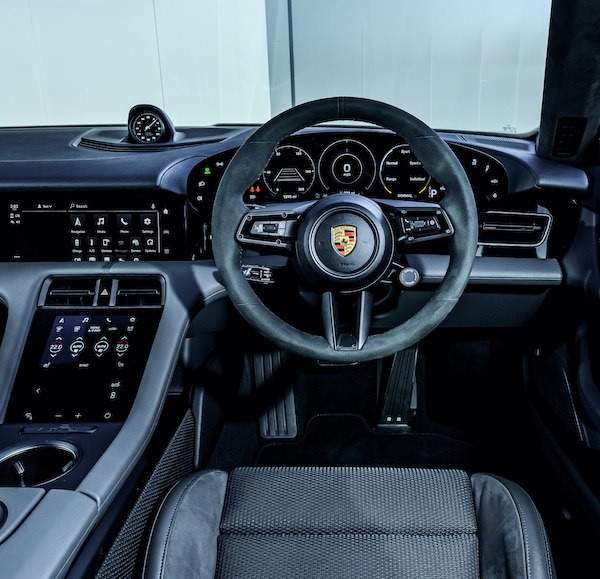
The Taycan has given electric vehicles a seriously sharp leap forward. Mark Walton straps himself in
Legend has it Enzo Ferrari once said: ‘I don’t sell cars, I sell engines! I give you the car for free!’ I say ‘legend’, because I’ll give a special prize to anyone who can find the original source for those words. Never mind – the quote lives on because the sentiment seems right.
Most supercars are dominated by their complex, highly tuned engines: the noise, the vibration, the feeling that there’s something explosive and alive under the bonnet. It’s no coincidence the greatest supercar of all time, the 1992 McLaren F1, also had the greatest engine, a BMW V12. I’ve driven an F1: it sounded like an orchestra of trombones.
This gives the new Porsche Taycan extra significance. This isn’t just Porsche’s first electric vehicle (EV); it’s the first production EV from any of the great supercar manufacturers – Ferrari, Lamborghini, McLaren… Porsche has beaten them all. That means it’s a clue to help answer the burning question: can supercars survive the electric revolution?
Porsche would point out, however, that the Taycan is ‘not a supercar’. It’s a four-door sports saloon, very close in size to its existing saloon, the Panamera, though the Taycan looks much leaner and sharper.
Despite the similarities, this is a completely new car, conceived from the ground up as an EV. It’s made with steel and aluminium, and the battery is in the floor. This drives two electric motors – one at the front axle, another at the rear– making the Taycan all-wheel drive. Unusually, for an electric car, the rear axle has two speeds: a low gear for acceleration, which automatically shifts to a higher gear for efficiency. More on that later.
There are three models: the 4S, Turbo and Turbo S. Wait – ‘Turbo’? Yes, I know, an electric car doesn’t have a turbocharger, the badge just denotes ‘very fast’. Shame – I imagine the marketing team patting themselves on the back while the engineers gnawed the ends off their pencils.
‘Turbo’ charged

Today I’m testing the Turbo, which means a starting price of £115,858. It has a 93kW battery, a claimed range of 272 miles and power output of 616bhp (with a further 55bhp available on ‘overboost’). Porsche has developed the Taycan around an 800-volt system, double the usual EV voltage, which means the battery can charge from 5 per cent to 80 per cent in just 22 minutes, if you can find a rare 270kW charger.
Climb into the Taycan and it feels very Porsche and ultramodern. You sit low in the sports seats, and our car has the optional ‘leather-free’ interior (£336), which means black fabric and a soft Alcantara steering wheel. The dashboard seamlessly blends gloss, piano-black panels with colour screens – two in the centre and an amazing, 16-inch curved screen ahead of the driver. If Apple designed a car interior, it would look like this.
‘It rides with the serene confidence of an Olympic sprinter out for a jog’
After pressing the ‘on’ button and selecting ‘Drive’ using a toggle on the dashboard, you glide away. The first thing you notice about the Taycan – and the second, third and probably last thing you’ll remember – is just how beautifully it moves down the road. It rides with the serene confidence of an Olympic sprinter out for a jog: honed, firm and flexible, soaking up bumps while remaining alert. There isn’t a millimetre of slack.
These feelings are consolidated by the build quality. EVs are silent, which means any cabin squeaks become a distraction. The Taycan interior feels rock solid, every switch and control engineered with a luxurious exactness.
Actually, the Taycan doesn’t have to be silent: our car is fitted with an optional Electric Sport Sound (£354). It provides a ‘zzzwwwee’ spaceship soundtrack for the Taycan’s next trick: its brain-boggling acceleration. EVs don’t need any build-up of revs to deliver peak power, and the Taycan can burst forward with shocking speed in an instant. Accelerating from 50mph makes you laugh; from a standstill it makes you cry.
On an empty road I stop, use a rotary switch to choose Sport Plus mode, then press both pedals. With the 671bhp ‘launch control’ now engaged, you just release the brake and wham! I actually moaned the first time I did it. You know when you turn upside down on a rollercoaster and you make that involuntary ‘Gnnnhhh’ noise? Well, the Taycan rams you forwards so hard it hurts. I did it three times, then felt I was going to puke.
Porsche quotes 0-62mph in 3.2 seconds and a top speed of 161mph, largely thanks to that two-speed electric rear axle.
Altogether, the Taycan is probably the best EV you can buy today, a car that finally shows Tesla what the European marques can really do. As for the future of supercars, the Taycan is slick and sophisticated but does lack the character – the orchestra – of a big-engined supercar. I know, I know, it’s a sports saloon – but after driving the Taycan, I wonder if supercars themselves have had their day, fading out with the sounds that made them so memorable. One thing’s for certain: we no longer need supercars for their speed.
This is the leader from issue 75 of Spear’s magazine, out now. Click here to buy the latest issue and subscribe
Read more from the issue:
Engineering the future: Lord Browne on why Britain should create again
Matthew Goodwin: Beware ‘confident’ predictions when it comes to Covid-19
Introducing issue 75 of Spear’s magazine
Cover Story: Is this the death of dividends?







